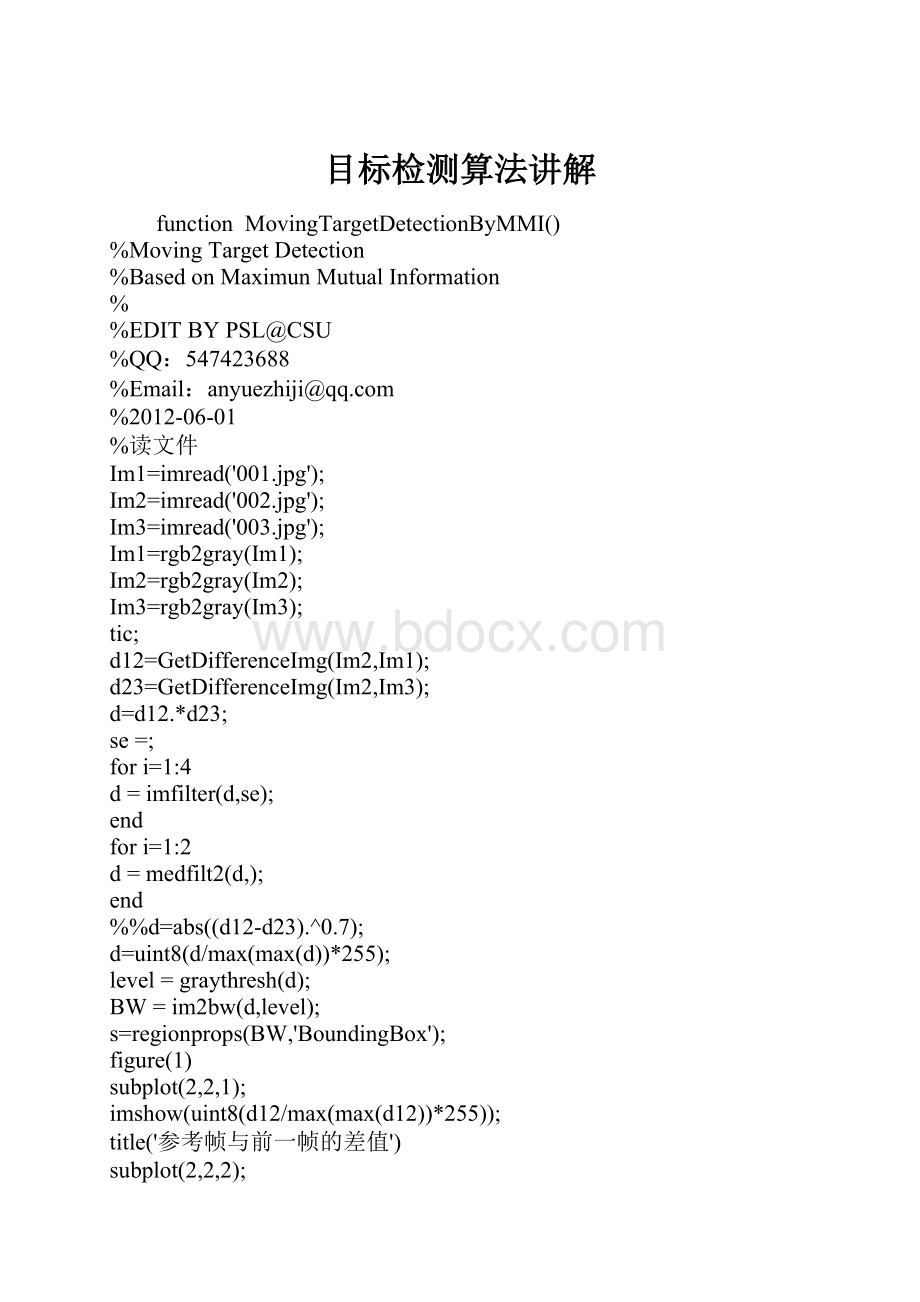目标检测算法讲解.docx
《目标检测算法讲解.docx》由会员分享,可在线阅读,更多相关《目标检测算法讲解.docx(17页珍藏版)》请在冰豆网上搜索。

目标检测算法讲解
function MovingTargetDetectionByMMI()
%MovingTargetDetection
%BasedonMaximunMutualInformation
%
%EDITBYPSL@CSU
%QQ:
547423688
%Email:
anyuezhiji@
%2012-06-01
%读文件
Im1=imread('001.jpg');
Im2=imread('002.jpg');
Im3=imread('003.jpg');
Im1=rgb2gray(Im1);
Im2=rgb2gray(Im2);
Im3=rgb2gray(Im3);
tic;
d12=GetDifferenceImg(Im2,Im1);
d23=GetDifferenceImg(Im2,Im3);
d=d12.*d23;
se=;
fori=1:
4
d=imfilter(d,se);
end
fori=1:
2
d=medfilt2(d,);
end
%%d=abs((d12-d23).^0.7);
d=uint8(d/max(max(d))*255);
level=graythresh(d);
BW=im2bw(d,level);
s=regionprops(BW,'BoundingBox');
figure
(1)
subplot(2,2,1);
imshow(uint8(d12/max(max(d12))*255));
title('参考帧与前一帧的差值')
subplot(2,2,2);
imshow(uint8(d23/max(max(d23))*255));
title('参考帧与后一帧的差值')
subplot(2,2,3);
imshow(BW);
title('由前后帧得出的差值')
subplot(2,2,4);
imshow(Im2);
%imshow(d);
rectangle('Position',s
(1).BoundingBox,'Curvature',,'LineWidth',2,'LineStyle','--','EdgeColor','r')
title('参考帧与检测结果')
%求相邻两帧重合部分差值主函数
functionoutImg=GetDifferenceImg(R,F)
=dwt2(R,'db1');
=dwt2(F,'db1');
CA1=uint8(CA1);
CA2=uint8(CA2);
fprintf('\n------PSOstart\n');
=PSO(CA1,CA2);
whilemi<1.2
=PSO(CA1,CA2);
end
fprintf('tx:
%f ty:
%f ang:
%fmi:
%f\n',pa
(1),pa
(2),pa(3),mi);
fprintf('------PSOend\n\n');
%pa=;
fprintf('------Powellstart\n');
mi_old=0;
whileabs(mi-mi_old)>0.01
mi_old=mi;
=powell(R,F,pa);
end
fprintf('------Powellend\n\n');
time=toc;
fprintf('tx:
%.4f ty:
%.4f ang:
%.2fmi:
%f\n',pa
(1),pa
(2),pa(3),mi);
fprintf('time:
%f\n',time);
outImg=GetDifference(pa
(1),pa
(2),pa(3),R,F);
%figure(6);imshow(outImg);
%求相邻两帧重合部分差值
functionoutImg=GetDifference(tx,ty,ang,R,F)
=size(R);
%
R=im2double(R);
F=im2double(F);
theta=ang*pi/180; %旋转角度转弧度
cx=floor(n/2); %旋转的中心点
cy=floor(m/2);
outImg=zeros(m,n);
forj=1:
m
fori=1:
n
%参考图像在浮动图像平移后的对应点
% x=i-tx; %列
% y=j-ty; %
x=(i-cx)*cos(theta)-(j-cy)*sin(theta)+cx-tx;
y=(i-cx)*sin(theta)+(j-cy)*cos(theta)+cy-ty;
x1=floor(x);
y1=floor(y);
rval=R(j,i);
%图像重合部分求差
if(x1>=1&&x10px;word-break:
break-all;word-wrap:
break-word;">=1&&y1 dy=y1-y;dx=x1-x;
%双线性插值
fval=(F(y1+1,x1)-F(y1,x1))*dy+(F(y1,x1+1)-F(y1,x1))*dx+(F(y1+1,x1+1)+F(y1,x1)-F(y1,x1+1)-F(y1+1,x1))*dy*dx+F(y1,x1);
outImg(j,i)=abs((rval-fval).^0.7*exp(-min()/20));
%outImg(j,i)=abs((rval-fval).^2.5/(min()).^0.2);
end
end
end
%outImg=uint8(outImg/max(max(outImg))*255);
%双线性插值求互信息
functionout=BI_mi(tx,ty,ang,R,F)
=size(R);
hist=zeros(256,256);
ha=zeros(1,256);
hb=zeros(1,256);
%归一化到256级灰度
%ifmax(max(r))~=min(min(r))%max(max(a))结果是A中最大的元素,max(A)结果一个行向量,元素分别是A的每个列向量的最大的元素
% r=(r-min(min(r)))/(max(max(r))-min(min(r)));
%else
% r=zeros(M,N);
%end
%
%ifmax(max(f))-min(min(f))
% f=(f-min(min(f)))/(max(max(f))-min(min(f)));
%else
% f=zeros(M,N);
%end
%
%r=double(int16(r*255))+1;
%f=double(int16(f*255))+1;
R=R+1;
F=F+1;
theta=ang*pi/180; %旋转角度转弧度
cx=floor(n/2); %旋转的中心点
cy=floor(m/2);
%求联合概率密度
forj=1:
m
fori=1:
n
%参考图像在浮动图像平移后的对应点
% x=i-tx; %列
% y=j-ty; %
x=(i-cx)*cos(theta)-(j-cy)*sin(theta)+cx-tx;
y=(i-cx)*sin(theta)+(j-cy)*cos(theta)+cy-ty;
x1=floor(x);
y1=floor(y);
rval=R(j,i);
%图像重合部分求差
if(x1>=1&&x10px;word-break:
break-all;word-wrap:
break-word;">=1&&y1 dy=y1-y;dx=x1-x;
%双线性插值
fval=(F(y1+1,x1)-F(y1,x1))*dy+(F(y1,x1+1)-F(y1,x1))*dx+(F(y1+1,x1+1)+F(y1,x1)-F(y1,x1+1)-F(y1+1,x1))*dy*dx+F(y1,x1);
hist(fval,rval)=hist(fval,rval)+1;
end
end
end
%下面求边缘概率密度
fori=1:
256
ha(i)=sum(hist(i,:
));
hb(i)=sum(hist(:
i));
end
%调用互信息函数
out=MI(hist,ha,hb);
%下面是求互信息的函数
functionmi=MI(hist,ha,hb)
%
hsum=sum(sum(hist));
index=find(hist~=0);
p=hist/hsum;
Hab=sum(sum(-p(index).*log(p(index))));%联合熵
hsum=sum(sum(ha));
index=find(ha~=0);
p=ha/hsum;
Ha=sum(sum(-p(index).*log(p(index)))); %边缘熵
hsum=sum(sum(hb));
index=find(hb~=0);
p=hb/hsum;
Hb=sum(sum(-p(index).*log(p(index)))); %边缘熵
mi=Ha+Hb-Hab;
%粒子群算法
function=PSO(R,F)
%粒子群算法
%初始化
D=3; %维数
ps=30; %种群规模
VRmin=ones(D,1)*-20; %最小速度
VRmax=ones(D,1)*20; %最大速度
VR=;
%minmax=1;
pos=40*rand(ps,D)-20; %随机产生初始位置
vel=8*rand(ps,D)-4; %产生随机速度
%ps=15; %种群规模
%VRmin=ones(D,1)*-10; %最小速度
%VRmax=ones(D,1)*10; %最大速度
%VR=;
%%minmax=1;
%pos=20*rand(ps,D)-10; %随机产生初始位置
%vel=4*rand(ps,D)-2; %产生随机速度
%一些参数
maxinterations=20; %最大迭代次数
iw=1; %固定权重
iw1=0.9; %最大惯性权重
iw2=0.4;
iwe=15;
ac1=2;
ac2=2;
flagg=1;
%ergrd=1e-5;
%ergrdep=5; %
%mv=4;%
ergrd=1e-4;
ergrdep=5; %
mv=4;%
%初始个体极值
pbest=pos;
%求初始全局极值
fori=1:
ps
p=pos(i,:
); %第i个粒子位置
out(i)=BI_mi(p
(1),p
(2),p(3),R,F); %求函数值
end
pbestval=out; %每个粒子当前函数值
=max(pbestval); %全局最优函数值
gbest=pbest(idx,:
); %全局极值
tr
(1)=gbestval; %保存当前全局最优函数值
%startPSOiterativeprocedures
cnt=0;%counterusedforupdatingdisplayaccordingtodfintheoptions
cnt2=0;%counterusedforthestoppingsubroutinebasedonerrorconvergence
%开始迭代
fori=1:
maxinterations
forj=1:
ps
ifflagg==1 %randomizationcontrol,onerandomsetforeachparticleateachepoch
rannum1=rand
(1);
rannum2=rand
(1);
end
p=pos(j,:
); %第i个粒子位置
out(j)=BI_mi(p
(1),p
(2),p(3),R,F); %求函数值
e(j)=out(j);
%更新pbest
ifpbestval(j)<=e(j);%%%====
pbestval(j)=e(j);
pbest(j,:
)=pos(j,:
);
end
%更新gbest
=max(pbestval);
ifgbestval<=iterbestval%%%===
gbestval=iterbestval;
gbest=pbest(idx1,:
);
end
tr(i+1)=gbestval;
te=i;
%%%%%%%%%%%%%%%%%%%%%%%%%%%%%%%%%%%%%%%%%%%%
%%%%%%更新速度,位置
%%%%%%%%%%%%%%%%%%%%%%%%%%%%%%%%%%%%%%%%%%%%
ifi<=iwe%%%===
iwt(i)=((iw2-iw1)/(iwe-1))*(i-1)+iw1; %惯性权重
else
iwt(i)=iw2;
end
%iwt(i)=1;
%%%%%%%%%%速度%%%%%%%%%%%%%%%%%%%%
ifflagg==2 %粒子的每个参数的随机数不同
fordimcnt=1:
D
rannum1=rand
(1);
rannum2=rand
(1);
vel(j,dimcnt)=iwt(i)*vel(j,dimcnt)...
+ac1*rannum1*(pbest(j,dimcnt)-pos(j,dimcnt))...
+ac2*rannum2*(gbest(1,dimcnt)-pos(j,dimcnt));
end
else %粒子的每个参数的随机数相同
vel(j,:
)=iwt(i)*vel(j,:
)...
+ac1*rannum1*(pbest(j,:
)-pos(j,:
))...
+ac2*rannum2*(gbest(1,:
)-pos(j,:
));
end
% 固定权重
% vel(j,:
)=iw*vel(j,:
)...
% +ac1*rannum1*(pbest(j,:
)-pos(j,:
))...
% +ac2*rannum2*(gbest(1,:
)-pos(j,:
));
%%%%%%%%%%位置%%%%%%%%%%%%%%%%%%%%%%%
pos(j,:
)=pos(j,:
)+vel(j,:
);
%%%%%%%%%速度和位置范围%%%%%%%%%
fordimcnt=1:
D
ifvel(j,dimcnt)>mv
vel(j,dimcnt)=mv;
end
ifvel(j,dimcnt)<-mv
vel(j,dimcnt)=-mv;
end
ifpos(j,dimcnt)>=VR(dimcnt,2)
pos(j,dimcnt)=VR(dimcnt,2);
end
ifpos(j,dimcnt)<=VR(dimcnt,1)%%%===
pos(j,dimcnt)=VR(dimcnt,1);
end
end
end %结束一次粒子循环
temp=gbest';
fprintf('%f,%f,%f,%f\n',temp
(1),temp
(2),temp(3),gbestval);
Y(i)=gbestval;
X(i)=i;
%收敛条件
tmp1=abs(tr(i)-gbestval);
iftmp1>ergrd
cnt2=0;
elseiftmp1<=ergrd%%%===
cnt2=cnt2+1;
ifcnt2>=ergrdep
break
end
end
end %迭代结束
fprintf('totalinterations:
%d\n',i);
%OUT=;
pa=gbest;
mi=gbestval;
%POWELL优化算法
function=powell(R,F,x)
len=5; %搜索区间
itmax=30;%最大循环次数
e=1e-3; %允许误差
%方向矢量矩阵存放d1,d2,d3三个方向矢量
D=;
%起始点
%x0=;
x0=x;
fx0=BI_mi(x0
(1),x0
(2),x0(3),R,F);
%fx0=pv_mi(x0
(1),x0
(2),-x0(3),R,F);
%循环搜索
fork=0:
itmax
%从起始点出发,沿d1方向搜索,得到最大值fx1,对应点x1
d1=D(1,:
);
=oneDimSearch(R,F,x0,d1,len);
fprintf('%f, %f, %f, %f\n',x1
(1),x1
(2),x1(3),fx1);
%从x1出发,沿d2方向搜索
d2=D(2,:
);
=oneDimSearch(R,F,x1,d2,len);
fprintf('%f, %f, %f, %f\n',x2
(1),x2
(2),x2(3),fx2);
%从x2出发,沿d3方向搜索
d3=D(3,:
);
=oneDimSearch(R,F,x2,d3,len);
%加速方向
dn=x3-x0;
y=sum(dn.*dn);
fprintf('%f\n',y);
fprintf('%f, %f, %f, %f\n',x3
(1),x3
(2),x3(3),fx3);
ify<=e %满足结束条件,退出循环%%%===
pa=x3;
mi=fx3;
return;
end
%调整搜索方向
%计算目标值下降最多的那个方向
cha=;
=max(cha);
%
xe=2*x3-x0;
fe=BI_mi(xe
(1),xe
(2),xe(3),R,F);
%fe=pv_mi(xe
(1),xe
(2),-xe(3),R,F);
%这里求极大值
if(fe<=fx0)||(2*(fx0-2*fx3+fe)*(fx0-fx3-maxcha)*(fx0-fx3-maxcha)>=(fx0-fe)*(fx0-fe)*maxcha)
%不引入新的方向%%%===
x0=x3; %下次搜索的新起点
fx0=fx3;
else %引进新的方向
%以xn为起点沿dn进行搜索,得到下次搜索的新起点
=oneDimSearch(R,F,x3,dn,len);
%替换方向
D(4,:
)=dn;
fori=j0:
3
D(i,:
)=D(i+1,:
);
end
end
end %endfor
pa=x3;
mi=fx3;
%一维搜索。
从-len到len,找出最大值的点
function=oneDimSearch(R,F,X,direction,len)
%一维brent搜索求函数最小值
CGOLD=0.3819660;
a=-len;
b=len;
%a=a0;
%b=b0;
tol=0.01;
e=0.0;
ITMAX=100;
v=a+CGOLD*(b-a);
Xv=X+direction*v;
%fv=pv_mi(Xv
(1),Xv
(2),-Xv(3),R,F);
fv=BI_mi(Xv
(1),Xv
(2),Xv(3),R,F);
w=v;
x=v;
fw=fv;
fx=fv;
fork=0:
ITMAX
xm=0.5*(a+b); %中点
tol1=tol*abs(x);
tol2=2*tol1;